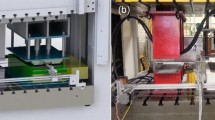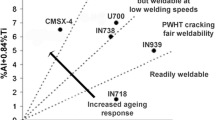Abstract
The metal working industry is continuously seeking for process chain improvements, involving, for instance, forging techniques, principally aiming at reducing the process costs, and improving the mechanical properties of the automotive parts. Promising new forging materials (e.g., high-strength ductile bainite ‘HDB’ steel alloy) offer new fields for process combinations, such as cold and warm forging, machining, and controlled in-process quenching. In the present paper, the design, implementation, and validation of a controlled gas and spray-quenching unit within an automated forging unit is described. A two-fluid, flat-spray nozzle is characterized for spray-quenching purposes (droplet size, mass flux, and heat-transfer distributions). Experiments are utilized to validate transient heat transfer simulations in order to extend the numerical model for quenching scenarios of complex specimen geometries (a stepped shaft and a common rail), involving various steel grades from the forging heat. The scenarios are validated using the automated forging/quenching unit, through hardness and microscopy tests. The high potential of the combination of forging and heat treatment (gas and spray-quenching) into a single manufacturing unit to ensure the homogeneous bainitizing of forged components is demonstrated in the present paper.











Similar content being viewed by others
Abbreviations
- A :
-
air
- Bi :
-
Biot-number [−]
- h, HTC :
-
heat transfer coefficient [W/(m2.K)]
- m:
-
mass [kg]
- Q3 :
-
cumulative particle size distribution [−]
- q3 :
-
particle size density distribution [1/m]
- t :
-
time [s]
- T :
-
temperature [°C]
- \( \dot{\mathrm{V}} \) :
-
flow rate [L/min]
- W:
-
water
References
Deiters TA, Mudawar I (1989) Optimization of spray quenching for aluminum extrusion, forging, or continuous casting. Journal of Heat Treating 7(1):9–18
Afazov SM, Becker AA, Hyde TH (2012) Development of a finite element data exchange system for chain simulation of manufacturing processes. Adv Eng Softw 47(1):104–113
Behrens BA, Bach FW, Bouguecha A, Nürnberger F, Schaper M, Yu Z, Klassen A (2012) Numerische Berechnung einer integrierten Wärmebehandlung für präzisionsgeschmiedete Bauteile. HTM Journal of Heat Treatment and Materials 67(5):337–343
Harrison CS (2013) A case study on automating a hot forge for manual and robotic operation. Control and Automation 2013: Uniting Problems and Solutions, 4–5 June 2013, Birmingham (UK)
Pola A, Gelfi M, La Vecchia GM (2013) Simulation and validation of spray quenching applied to heavy forgings. J Mater Process Technol 213(12):2247–2253
Hu FZ, Hui WJ, Yong QL (2013) High-cycle fatigue fracture behavior of microalloyed bainitic steels for hot forging. Adv Mater Res 634:1746–1751
Elek L, Fischer C, Melz T, Wagener R, Wirths V, Bleck W (2014) New generation of forging steels for cyclic loaded safety components with improved fatigue properties. SAE Technical Paper No. 2014–28-0005
Wirths V, Wagener R, Bleck W, Melz T (2014) Bainitic forging steels for cyclic loading. Adv Mater Res 922:813–818
Löser K, Heuer V (2006) Distortion control by innovative heat treating technologies in the automotive industry. HTM Härtereitechnische Mitteilungen 61(6):326–329
Visaria M, Mudawar I (2009) Application of two-phase spray cooling for thermal management of electronic devices. Components and Packaging Technologies 32(4):784–793
Hall DD, Mudawar I, Morgan RE, Ehlers SL (1997) Validation of a systematic approach to modeling spray quenching of aluminum alloy extrusions, composites, and continuous castings. J Mater Eng Perform 6(1):77–92
Mudawar I, Deiters TA (1994) A universal approach to predicting temperature response of metallic parts to spray quenching. Int J Heat Mass Transf 37(3):347–362
Hall DD, Mudawar I (1996) Optimization of quench history of aluminum parts for superior mechanical properties. Int J Heat Mass Transf 39(1):81–95
Wendelstorf J, Spitzer KH, Wendelstorf R (2008) Spray water cooling heat transfer at high temperatures and liquid mass fluxes. Int J Heat Mass Transf 51(19):4902–4910
Soltani M, Pola A, La Vecchia GM, Modigell M (2015) Numerical method for modelling spray quenching of cylindrical forgings. La Metallurgia Italiana 7/8 2015:29–37
Reich M, Schöne S, Keßler O, Nowak M, Grydin O, Nürnberger F, Schaper M (2010) Simulation of gas and spray quenching during extrusion of aluminium alloys. In Key Engineering Materials 424:57–64
Fritsching U, Bucquet T (2014) Resource-efficient process chains for high-performance steel components. International Forging Conference, 30 July 2014, Berlin (Germany)
Keul C, Wirths V, Bleck W (2012) New bainitic steels for forgings. Archives of Civil and Mechanical Engineering 12(2):119–125
Fischer M et al (2014) Ecoforge: Energieeffiziente Prozesskette von Hochleistungs-Schmiedebauteilen am Beispiel eines hochfesten, duktilen bainitischen (HDB) Stahls. HTM Journal of Heat Treatment and Materials 69(4):209–219
Schüttenberg S, Hunkel M, Fritsching U, Zoch HW (2006) Controlling of distortion by means of quenching in adapted jet fields. Mat-wiss u Werkstofftech 37:92–96
Stark P, Schuettenberg S, Fritsching U (2011) Spray quenching of specimen for ring heat treatment. Computational methods in multiphase flow VI. WIT Trans on Eng Sciences 70:201–212
Schüttenberg S, Lütjens J, Hunkel M, Fritsching U (2012) Adapted spray quenching for distortion control. Mat.-wiss. u. Werkstofftech. 43:99–104
Hinrichs B, Hornig N, Schüttenberg S, Fritsching U (2012) Controlled spray quenching in heat treatment process. ICLASS 2012, 2–6 September 2012, Heidelberg (Germany)
Stark P (2012) Simulation of quenching process with liquid jets and sprays. 6th International Conference on Quenching and Control of Distortion, 9–13 September 2012, Chicago (USA)
Hornig N, Rose A, Fritsching U, von Hehl A (2013) Kontrollierte Abschreckung von Aluminiumbauteilen durch Sprühkühlen. HTM Journal of Heat Treatment and Materials 68(4):179–187
Kim J (2007) Spray cooling heat transfer: the state of the art. Int J Heat Fluid Flow 28(4):753–767
Liscic B, Tensi HM, Canale LC, Totten GE (2011) Quenching theory and technology. CRC Press, Boca Raton
Bucquet T, Fritsching U (2014) Adaptive spray-quenching for process integrated heat treatment of high-performance forged components. 21st IFHTSE Congress, 12–15 May 2014, Munich (Germany)
Hinrichs B, Reimche W, Bruchwald O, Frackowiak W, Fritsching U, Bach FW (2012) Sensorkontrolliertes Bainitisieren im Spraydüsenfeld. GWI Gaswärme International 3:77–85
Behrens BA, Huskic A, Kazhai M (2014) Experimentelle und numerische Untersuchungen zur kontrollierten Wärmebehandlung von hochbeanspruchten Stahlschmiedebauteilen. Um-formtechnisches Kolloquium Hannover, 27 February 2014, Hannover (Germany)
Reimche W, Bruchwald O, Frackowiak W, Bach FW, Maier HJ (2014) Hochleistungsbauteile für den Leichtbau mit sensorkontrollierter Bainitumwandlung aus der Schmiedewärme. Tagung Massiver Leichtbau im Automobilbau, 18–19 November 2014, Stuttgart (Germany)
Bruchwald O, Frackowiak W, Reimche W, Maier HJ (2015) Non-destructive in situ monitoring of the microstructural development in high performance steel components during heat treatment. La Metallurgia Italiana 11/12 2015:29–37
Bucquet T, Sander S, Fritsching U (2014) Characterization of spray nozzles for quenching of metal components. 26th European Conference on Liquid Atomization & Spray Systems 08–10 September 2014, Bremen (Germany)
Stark P, Fritsching U (2011) Modeling and simulation of film and transitional boiling processes on a metallic cylinder during quenching. Journal of ASTM International, STP1534, Film and Nucleate Boiling Processes 8.10:61–80
Acknowledgements
The authors gratefully acknowledge the financial support of this project under “Leading Technologies for Tomorrow” fundings from the AiF (Arbeitsgemeinschaft industrieller Forschungsvereinigungen “Otto von Guericke” e.V.) through resources from the BMWi (Bundesministerium für Wirtschaft und Energie).
Author information
Authors and Affiliations
Corresponding author
Ethics declarations
This study was funded by the AiF (Arbeitsgemeinschaft industrieller Forschungsvereinigungen “Otto von Guericke” e.V.) through resources from the BMWi (Bundesministerium für Wirtschaft und Energie).
Conflict of interest
The authors declare that they have no conflict of interest.
Rights and permissions
About this article
Cite this article
Bucquet, T., Hoja, T., Waldeck, S. et al. Process-integrated gas- and spray-quenching for high-strength ductile forged components. Int J Mater Form 11, 1–10 (2018). https://doi.org/10.1007/s12289-016-1336-1
Received:
Accepted:
Published:
Issue Date:
DOI: https://doi.org/10.1007/s12289-016-1336-1




